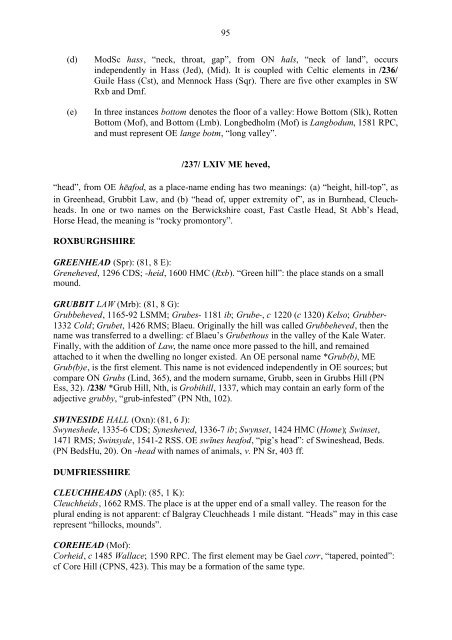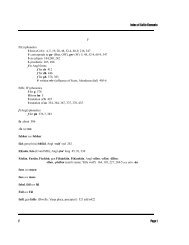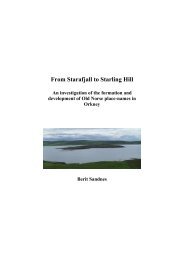May Williamson: The Non-Celtic Place-Names of the Scottish Border ...
May Williamson: The Non-Celtic Place-Names of the Scottish Border ...
May Williamson: The Non-Celtic Place-Names of the Scottish Border ...
You also want an ePaper? Increase the reach of your titles
YUMPU automatically turns print PDFs into web optimized ePapers that Google loves.
95<br />
(d)<br />
(e)<br />
ModSc hass, “neck, throat, gap”, from ON hals, “neck <strong>of</strong> land”, occurs<br />
independently in Hass (Jed), (Mid). It is coupled with <strong>Celtic</strong> elements in /236/<br />
Guile Hass (Cst), and Mennock Hass (Sqr). <strong>The</strong>re are five o<strong>the</strong>r examples in SW<br />
Rxb and Dmf.<br />
In three instances bottom denotes <strong>the</strong> floor <strong>of</strong> a valley: Howe Bottom (Slk), Rotten<br />
Bottom (M<strong>of</strong>), and Bottom (Lmb). Longbedholm (M<strong>of</strong>) is Langbodum, 1581 RPC,<br />
and must represent OE lange botm, “long valley”.<br />
/237/ LXIV ME heved,<br />
“head”, from OE hafod, as a place-name ending has two meanings: (a) “height, hill-top”, as<br />
in Greenhead, Grubbit Law, and (b) “head <strong>of</strong>, upper extremity <strong>of</strong>”, as in Burnhead, Cleuchheads.<br />
In one or two names on <strong>the</strong> Berwickshire coast, Fast Castle Head, St Abb’s Head,<br />
Horse Head, <strong>the</strong> meaning is “rocky promontory”.<br />
ROXBURGHSHIRE<br />
GREENHEAD (Spr): (81, 8 E):<br />
Greneheved, 1296 CDS; -heid, 1600 HMC (Rxb). “Green hill”: <strong>the</strong> place stands on a small<br />
mound.<br />
GRUBBIT LAW (Mrb): (81, 8 G):<br />
Grubbeheved, 1165-92 LSMM; Grubes- 1181 ib; Grube-, c 1220 (c 1320) Kelso; Grubber-<br />
1332 Cold; Grubet, 1426 RMS; Blaeu. Originally <strong>the</strong> hill was called Grubbeheved, <strong>the</strong>n <strong>the</strong><br />
name was transferred to a dwelling: cf Blaeu’s Grubethous in <strong>the</strong> valley <strong>of</strong> <strong>the</strong> Kale Water.<br />
Finally, with <strong>the</strong> addition <strong>of</strong> Law, <strong>the</strong> name once more passed to <strong>the</strong> hill, and remained<br />
attached to it when <strong>the</strong> dwelling no longer existed. An OE personal name *Grub(b), ME<br />
Grub(b)e, is <strong>the</strong> first element. This name is not evidenced independently in OE sources; but<br />
compare ON Grubs (Lind, 365), and <strong>the</strong> modern surname, Grubb, seen in Grubbs Hill (PN<br />
Ess, 32). /238/ *Grub Hill, Nth, is Grobihill, 1337, which may contain an early form <strong>of</strong> <strong>the</strong><br />
adjective grubby, “grub-infested” (PN Nth, 102).<br />
SWINESIDE HALL (Oxn): (81, 6 J):<br />
Swyneshede, 1335-6 CDS; Synesheved, 1336-7 ib; Swynset, 1424 HMC (Home); Swinset,<br />
1471 RMS; Swinsyde, 1541-2 RSS. OE swīnes heafod, “pig’s head”: cf Swineshead, Beds.<br />
(PN BedsHu, 20). On -head with names <strong>of</strong> animals, v. PN Sr, 403 ff.<br />
DUMFRIESSHIRE<br />
CLEUCHHEADS (Apl): (85, 1 K):<br />
Cleuchheids, 1662 RMS. <strong>The</strong> place is at <strong>the</strong> upper end <strong>of</strong> a small valley. <strong>The</strong> reason for <strong>the</strong><br />
plural ending is not apparent: cf Balgray Cleuchheads 1 mile distant. “Heads” may in this case<br />
represent “hillocks, mounds”.<br />
COREHEAD (M<strong>of</strong>):<br />
Corheid, c 1485 Wallace; 1590 RPC. <strong>The</strong> first element may be Gael corr, “tapered, pointed”:<br />
cf Core Hill (CPNS, 423). This may be a formation <strong>of</strong> <strong>the</strong> same type.




